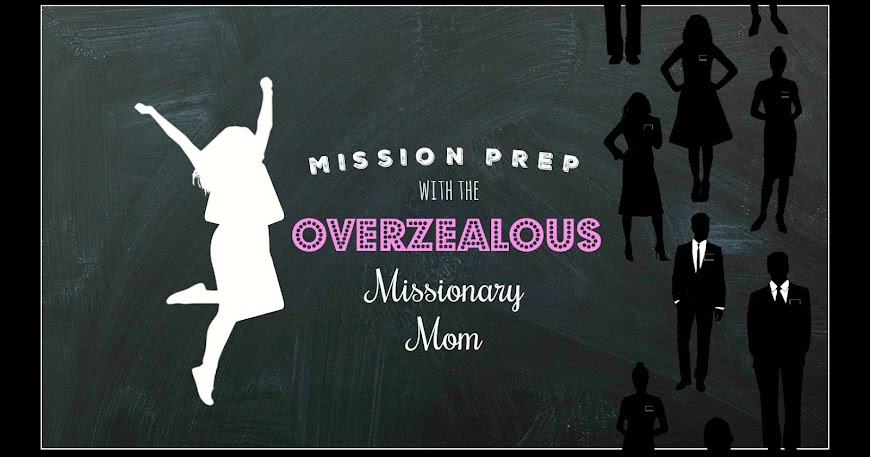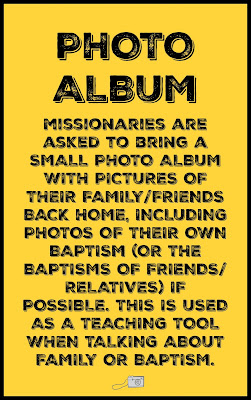If you are planning on serving a full-time mission for the Church of Jesus Christ of Latter-day Saints, it can seem like time is going SO SLOW - you wait until you are old enough (or until you have everything prepared) and then when you finally get all of your paperwork completed and submitted, you WAIT again for that call to arrive. While I was waiting for my mission call to arrive, it seemed like the days were stretching out longer than before....it seemed to take FOREVER!
No matter where you are in the process, you will be making your spiritual preparations (prayer, scripture study, etc), personal physical & mental preparations (getting into shape, making sure you are ready for the mental & physical requirements of a mission, getting your medical paperwork in order) & saving up money..but there isn't a lot you can do as far as purchasing the physical items (like shoes) that you will need for your mission until you get your call...
There are some things you CAN purchase before you know where you will be serving (see my blog post "10 things you can actually buy before you receive your mission call" here and you can learn about how to go about "buying some of your mission clothes before you receive you mission call" here)...but is there anything ELSE you can do to "get ready" while you wait?
If you are a "planner" or just want to do everything possible ahead of time (to avoid a big time-crunch later), here are a few more things that you can prepare NOW to take with you on your mission, NO MATTER WHERE YOU WILL BE SERVING...
Best of all, these are 5 things that you can make yourself
at little or no cost...
#1- PHOTO ALBUM
 |
| Examples $1 photo albums from the dollar store. The cover paper is removable, so you can replace with a different paper that you like better, or make a custom label if you want. |
 |
| Here is an example of a customized photo album from the Lovely Little Snippets blog here |
A photo album like this is useful for showing investigators and members who ask about your home town/country and family. This helps missionaries seem more personable and relatable- like "real people"! :) If possible, it is ideal to include photos from your own baptism (and/or baptisms from family members or friends). Family photos are great visual aids when you are teaching about family. Baptism photos are very useful when teaching about baptism and helping investigators to prepare for their own baptism.
NOTE- all photos in your photo album that you will use to show investigators/members should be missionary appropriate. This doesn't mean you need to be dressed in missionary clothes in all the photos, it means that you need to be representing yourself and your family/friends in a missionary-appropriate way. Appropriate photos would be things like family photos, baptism photos, photos from your missionary farewell, etc. You can always have a separate photo album for your own use in your apartment, showing to companions, etc (that would be more appropriate for things like photos of boyfriends/girlfriends, prom photos, photos that might not be appropriate to show investigators, like if you are wearing a swimsuit, etc). The photo album that you take out with you when you are teaching should only have photos that are 100% missionary-appropriate. Remember that while its okay to show your individually and personality as a missionary, you do want to present a professional image as well.
#2- PEDIGREE CHART
Instead of just printing out a chart on regular printer paper, I recommend having a pedigree chart printed as a 4"x6" (regular photo size). Since you will also need to have a family photo album (mentioned in #1 above), it would be convenient to have your pedigree chart inside the same photo album. This will also help keep it protected from being bent, getting water damage, etc.
If you don't have your information entered on familysearch.org so that it is printable, or if you just want something that looks a little nicer, I offer two types of printable pedigree charts in my Etsy Shop-
This is a pedigree chart digital file that you can purchase in my Etsy Shop and have printed as a 4x6 photo and then add your own names to (either with ink pen/sharpie) OR you can purchase it and use a photo-editing program to add your names digitally (and then print it as a 4x6 photo):
 |
| Available for purchase in my Etsy Shop here |
This is a pedigree chart especially for missionaries that you can purchase in my Etsy Shop and I will customize it with your name and the names of your ancestors (parents, grandparents, and great-grandparents) for you. You will then receive a customized pedigree chart (complete with your names) as a digital file that you can print as a 4x6 photo:
 |
| Available for purchase in my Etsy Shop here |
#3- HAIRSTYLE BOOK
This one is just for the Sisters! Unless you have very short Pixie haircut, you have a lot of hairstyle options as a missionary. Even if you normally wear your hair the same way every day, you will probably be ready to try something different after months of wearing the same outfits. Hairstyle is something you can easily change. And changing your hairstyle is also an easy way to dress-up your look a little more for special occasions like conferences, baptisms, meetings, etc. Even if you are currently pretty high-maintenance when it comes to doing your hair, you will want to prepare some quicker options. You usually won't have that much time to fix your hair, and there will be days when something comes up (like the electricity is out) or you are just too tired to deal with it. Find some styles that can hide the fact that your hair is frizzy or not totally dry yet. Find some styles that will work when it is humid or when you are outside in the rain all day.
You can find many ideas for hairstyles on Pinterest (here are some examples):
 |
| "9 Wet Hairstyles" from Twist Me Pretty here |
 |
| A few of the suggested "Sister Missionary Hairstyles" from lds.org |
 |
| 10 Hairstyles that Take Less than 10 Minutes from totalbeauty.com here |
Of course, you won't have access to Pinterest during your mission, so you will need to print anything you want to take as a reference. You can make a separate book for this (like a photo album with print-outs inside), or just glue printed pages into your address book or in the back of a journal). If you are artistic, you could even do sketches of hairstyle options! If it is a complicated hairdo (like a braid or a fancy bun), make sure you include the instructions!
"Sis Mish - One Stop" has a free printable document with step by step hairstyle instructions that you can cut & paste (made specifically for sister missionaries):
#4- EXERCISE PROGRAMS
You will get tired of doing the same exercises every day and it will be hard to be creative and come up with new and exciting things to do when you are already tired (and have limited time). You can only do so many jumping jacks without being bored out of your mind. Right now, if you wanted some new exercise ideas to do today, you'd probably look online and find some different ideas in just a few seconds. For your mission, you're going to need to plan ahead and bring a variety of options with you. And keep in mind that you won't have access to any gear (like a jump-rope) unless you bring it with you.
Here are a few examples that are geared towards women (mainly because of the colors and models). You can find plenty of gender-neutral or masculine versions of workouts online.
"Sis Mish - One Stop" has a free printable document with step by step hairstyle instructions that you can cut & paste (made specifically for sister missionaries):
 |
| Free printable hairstyle instructions from Sis Mish - One Stop here |
#4- EXERCISE PROGRAMS
You will get tired of doing the same exercises every day and it will be hard to be creative and come up with new and exciting things to do when you are already tired (and have limited time). You can only do so many jumping jacks without being bored out of your mind. Right now, if you wanted some new exercise ideas to do today, you'd probably look online and find some different ideas in just a few seconds. For your mission, you're going to need to plan ahead and bring a variety of options with you. And keep in mind that you won't have access to any gear (like a jump-rope) unless you bring it with you.
Here are a few examples that are geared towards women (mainly because of the colors and models). You can find plenty of gender-neutral or masculine versions of workouts online.
 |
| Example workouts from Jessicaautumn.com here |
 |
| 8 Best Workouts to Do in Under 10 Minutes here |
 |
| Sample workouts here |
 |
| Printable exercise programs and ideas from Sis Mish - One Stop here |
#5- LAUNDRY CHEAT-SHEET
A regular laundry stain-stick will work for a lot of things, but there are some stains that are more stubborn than that (and there is more than one way to remove different types of stains). It's a good idea to have a cheat-sheet available that will help you be better prepared to get stains out of your precious (limited!) wardrobe.
Here is a basic common stain removal chart:
 |
| Free printable here |
 | |
| Free printable here |
 |
| Free printable here |
For more ideas on preparing for your mission (even if you haven't received your call yet!) see all of my blog posts listed on the right side of the page! Thanks for stopping by!

































